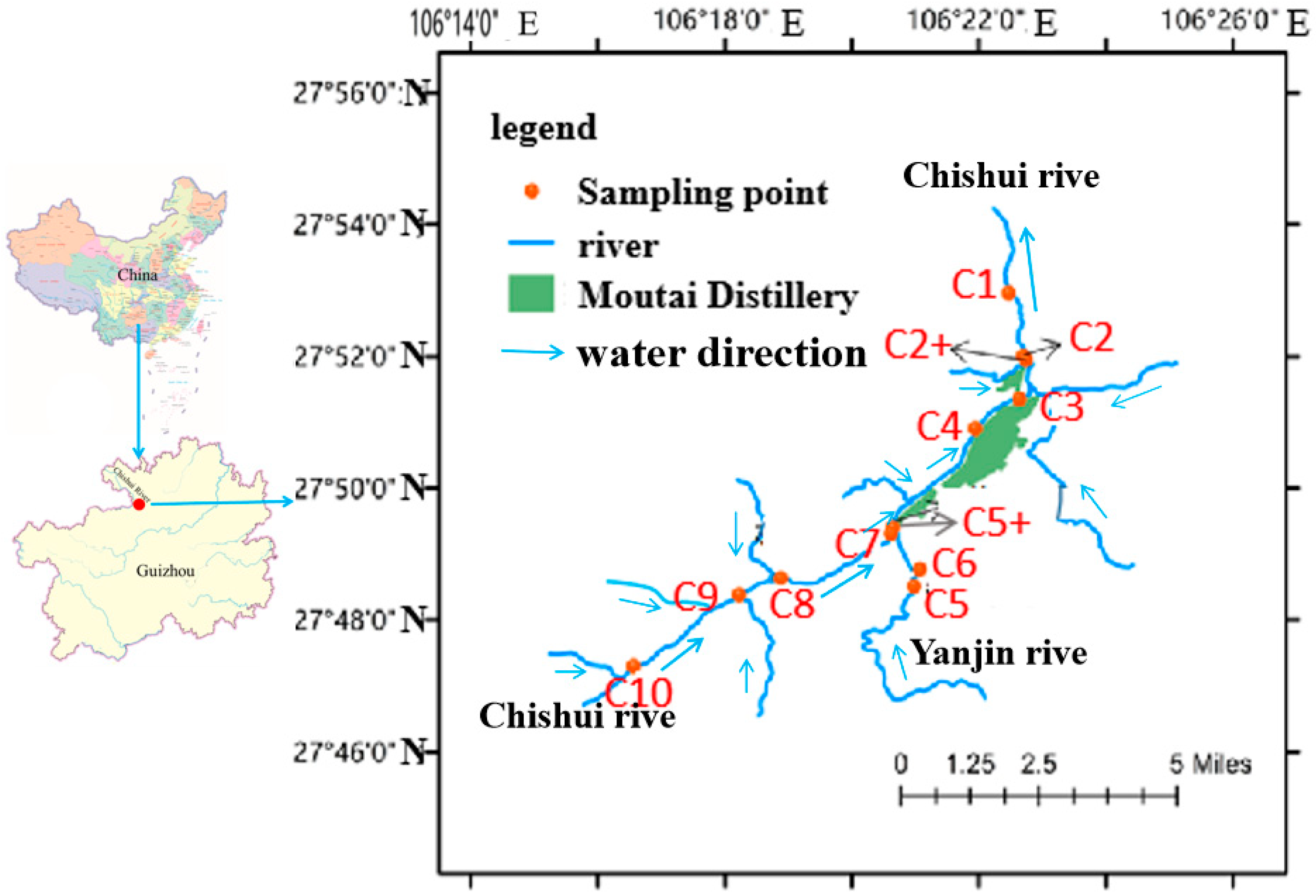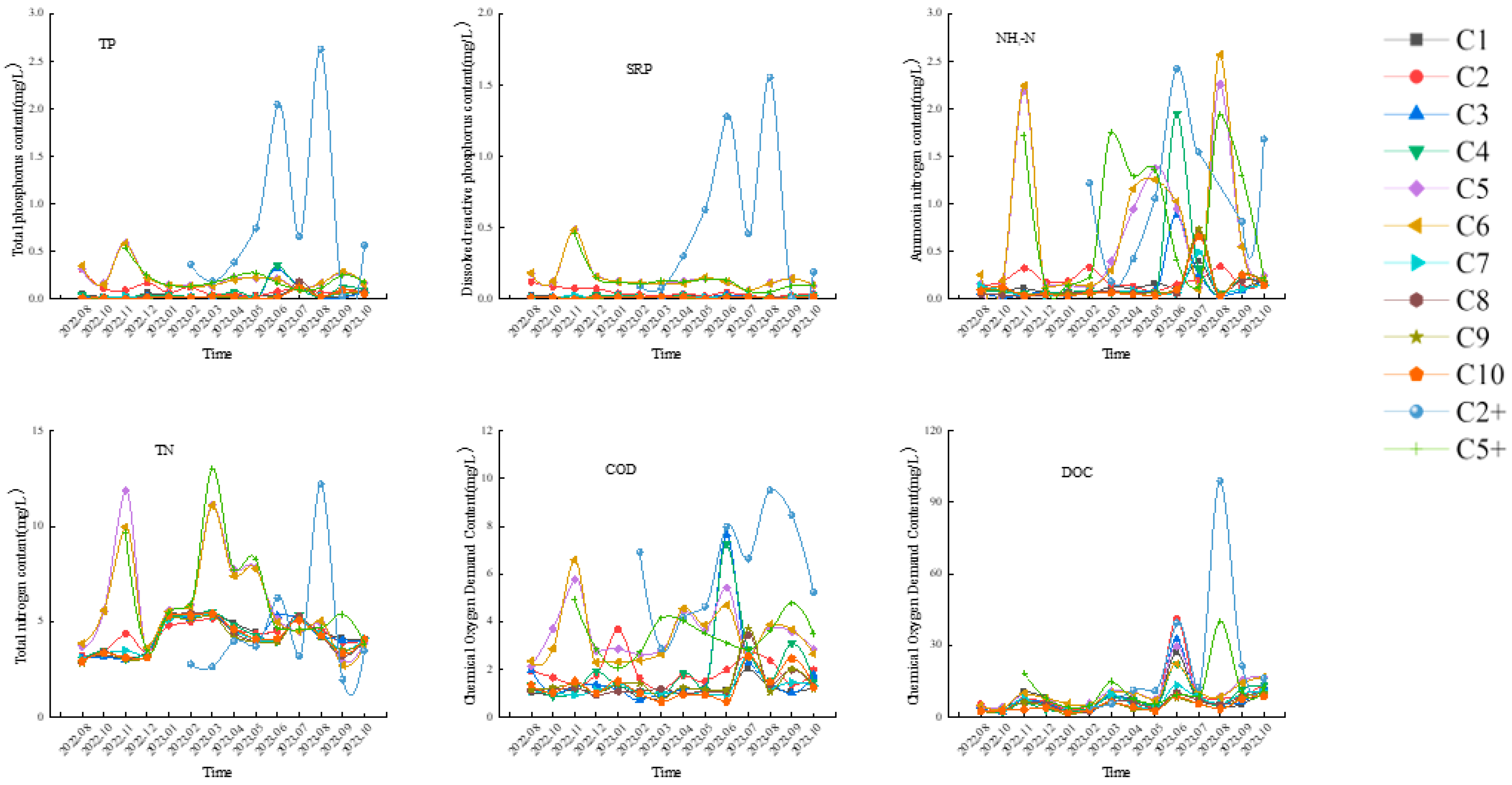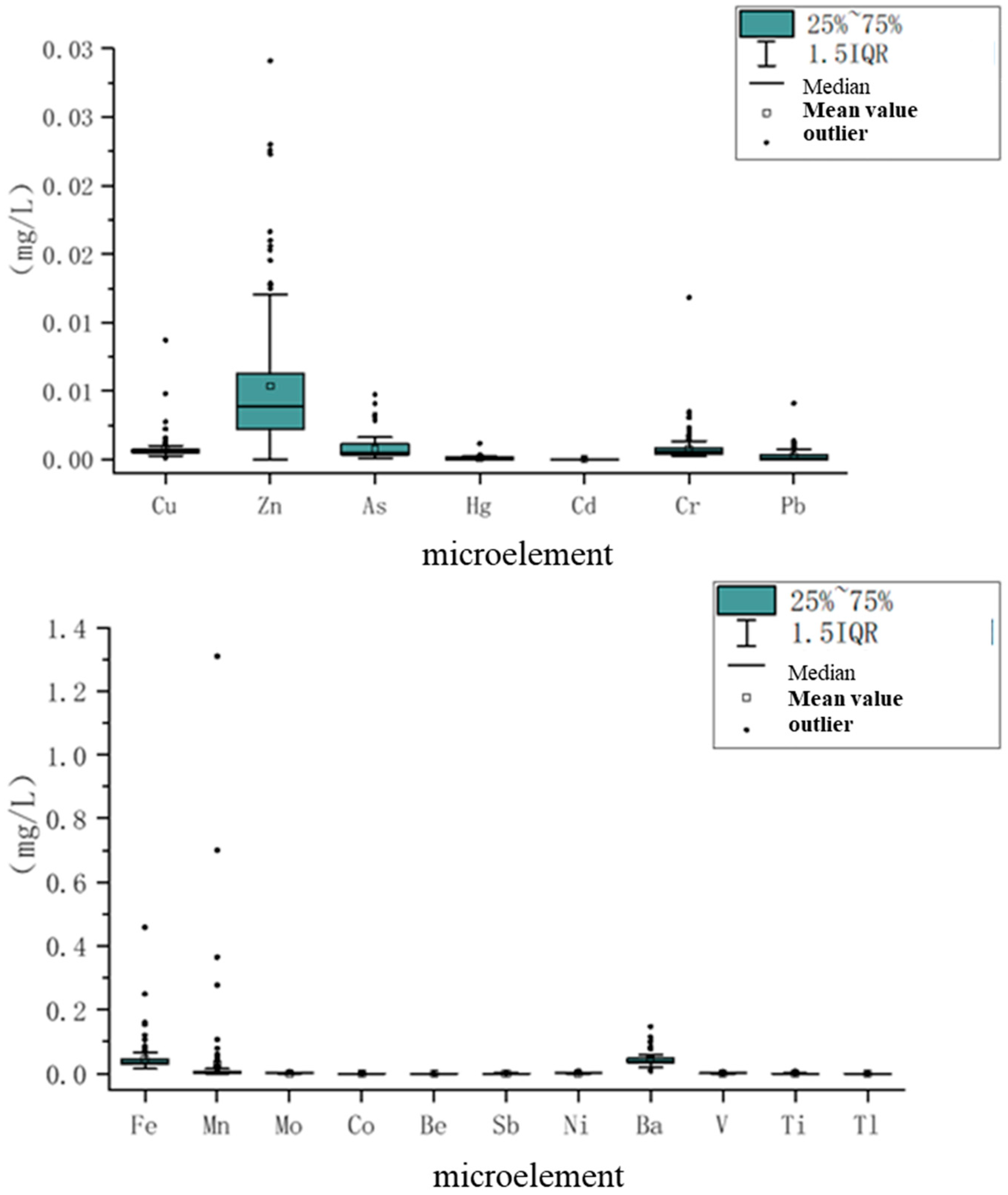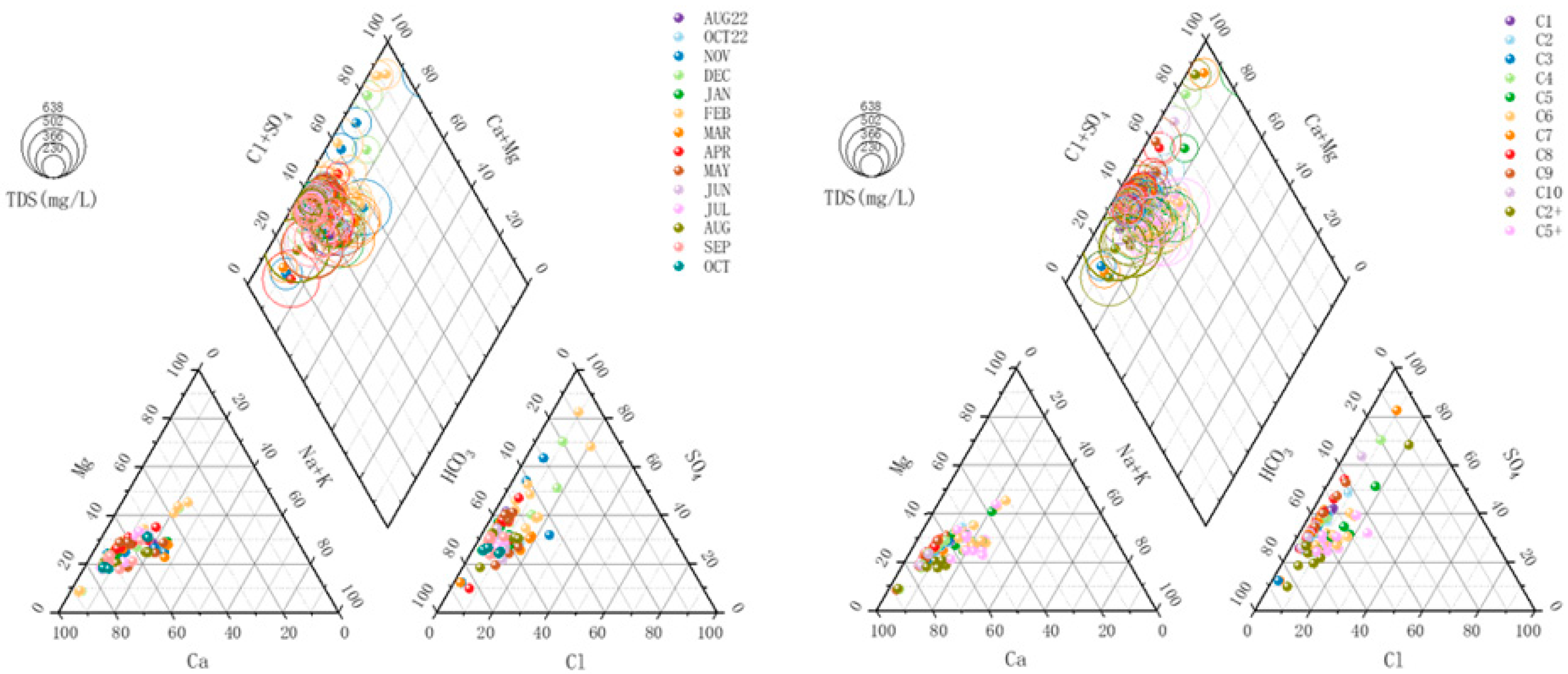Research on the Spatiotemporal Characteristics and Driving Factors of Water Quality in the Midstream of the Chishui River
Abstract
1. Introduction
2. Materials and Methods
2.1. Overview of the Research Area
2.2. Sampling Point Setting
2.3. Testing Methods
2.4. Data Analysis Methods
2.5. Evaluation of Water Quality of Main and Tributary
3. Results and Discussion
3.1. Analysis of Basic Indicators of Main and Tributary Rivers
3.2. Trace Elements
3.3. Differences in Water Quality Between Main and Tributary Rivers and Their Driving Factors
3.3.1. Evaluation of Water Quality of Main and Tributary Rivers
3.3.2. Differences in Water Quality (Spatially) Between Main and Tributary Rivers and Their Driving Factors
3.4. Differences in Time Between Cations and Anions and Their Driving Factors
3.5. The Primary Driving Factors of Monthly Variations in Water Quality
4. Conclusions
- (1)
- Most of the water bodies in the Midstream of the Chishui River belong to Class II water according to the “Environmental Quality Standards for Surface Water” (GB3838-2002), indicating relatively good overall water quality. The ionic composition of the river water is dominated by Ca2+ and HCO3−, followed by Mg2+ and SO32−, with the ionic composition primarily controlled by regional lithology.
- (2)
- Spatially, the water quality of the main river is superior to that of tributaries more significantly affected by human activities. Both the single-factor evaluation method and the Nemerow comprehensive evaluation method demonstrate good overall water quality in the Midstream of the Chishui River. The main river maintains water quality better than Class II surface water standards throughout the year, accounting for 98% of monitoring results. However, tributaries near Maotai Hotel and the Yanjin River estuary each showed one instance of water quality below Class II standards or moderate pollution.
- (3)
- Temporally, the water quality is better in winter and spring than in summer and autumn. Most indicators show higher values during summer, with precipitation and human activities exerting significant impacts on water quality during this period.
Author Contributions
Funding
Data Availability Statement
Conflicts of Interest
References
- Lei, Y.; Dong, F.; Liu, X.; Ma, B.; Huang, W. Short-term variations and correlations in water quality after dam removal in the chishui river basin. J. Environ. Manag. 2023, 327, 116917. [Google Scholar] [CrossRef]
- Li, J.; Cao, Y.; Pattison, Z.; Fu, W.; Sun, J. Does dam construction increase the biotic homogenization of riparian vegetation along a regulated river? River Res. Appl. 2024, 40, 1437–1444. [Google Scholar] [CrossRef]
- Ji, R.; Wang, C.; Wang, P.; Wang, W.; Chen, N. Quantitative analysis of spatiotemporal disparity of urban water use efficiency and its driving factors in the Yangtze River Economic Belt, China. J. Hydrol. Reg. Stud. 2024, 51, 101647. [Google Scholar] [CrossRef]
- Li, J.; Ouyang, Z.; Liu, P.; Zhao, X.; Wu, R.; Zhang, C.; Lin, C.; Li, Y.; Guo, X. Distribution and characteristics of microplastics in the basin of Chishui River in Renhuai, China. Sci. Total Environ. 2021, 773, 145591. [Google Scholar] [CrossRef] [PubMed]
- An, Y.L.; Lv, J.M.; Luo, J.; Wu, Q.X.; Jiang, H.; Peng, W.B.; Yu, X. Hydro-chemical Characteristics of Upper Chishui River Basin in Dry Season. Environ. Sci. Technol. 2015, 38, 117–122. (In Chinese) [Google Scholar]
- Xu, S.; Li, S.L.; Zhong, J.; Su, J.; Chen, S. Hydrochemical characteristics and chemical weathering processes in Chishui River Basin. Chin. J. Ecol. 2018, 37, 667–678. (In Chinese) [Google Scholar]
- Ge, X.; Wu, Q.; Wang, Z.; Gao, S.; Wang, T. Sulfur isotope and stoichiometry–based source identification of major ions and risk assessment in Chishui River Basin, Southwest China. Water 2021, 13, 1231. [Google Scholar] [CrossRef]
- Min, Y. Temporal and Spatial Distribution Characteristics and Interrelationships of Runoff, Sediment and Total Phosphorus in the Mainstream of Chishui River. Master’s Thesis, Changjiang River Scientific Research Institute, Wuhan, China, 2021. (In Chinese). [Google Scholar]
- Xu, S.; Lang, Y.; Zhong, J.; Xiao, M.; Ding, H. Coupled controls of climate, lithology and land use on dissolved trace elements in a karst river system. J. Hydrol. 2020, 591, 125328. [Google Scholar] [CrossRef]
- Jiang, Y.F.; An, Y.L.; Wang, Z.H.; Wu, Q.X.; Qin, L.; Zhang, J.; Shen, Y.Y. Analysis Spatial Distribution and Sources of Dissolved Trace Elements in the Water of Chishui River. Resour. Environ. Yangtze Basin 2021, 30, 1202–1210. (In Chinese) [Google Scholar]
- Xu, S.; Li, S.; Zhong, J.; Li, C. Spatial scale effects of the variable relationships between landscape pattern and water quality: Example from an agricultural karst river basin, southwestern china. Agric. Ecosyst. Environ. 2020, 300, 106999. [Google Scholar] [CrossRef]
- An, Y.L.; Jiang, H.; Wu, Q.X.; Yang, R.D.; Lang, X.; Luo, J. Assessment of water quality in the chishui river basin during low water period. Resour. Environ. Yangtze Basin 2014, 23, 1472–1478. (In Chinese) [Google Scholar]
- Cui, M.; Guo, Q.; Wei, R.; Tian, L. Human-driven spatiotemporal distribution of phosphorus flux in the environment of a mega river basin. Sci. Total Environ. 2021, 752, 141781. [Google Scholar] [CrossRef] [PubMed]
- Song, Y. P2P Evaluated Priority based Data Scheduling Mechanism Research in P2P Streaming Media System. Master’s Thesis, Ocean University of China, Qingdao, China, 2011. (In Chinese). [Google Scholar]
- Shi, K.; Zhao, Y.; Wu, C.; Geng, Y.; Zhou, S.; Chai, B. Revealing the distribution characteristics and key driving factors of dissolved organic matter in baiyangdian lake inflow rivers from different seasons and sources. Sci. Total Environ. 2024, 951, 175768. [Google Scholar] [CrossRef]
- Yang, L.; Liu, L.; Liu, Y.; Chen, G.; Liang, L. Hydrodynamic Groundwater Modeling and Hydrochemical Conceptualization of the Closure Mining Area of the WuMa River Watershed of China. ACS Omega 2023, 9, 520–537. [Google Scholar] [CrossRef]
- Zhao, Z.; Shen, Y.; Wang, Q.; Jiang, R. The temporal stability of soil moisture spatial pattern and its influencing factors in rocky environments. CATENA 2020, 187, 104418. [Google Scholar] [CrossRef]
- Zhu, J.; Peng, S.; Shen, X.; Lin, Z.; Gong, L.; Zhang, R.; Huang, B. Multiple scale impacts of land use intensity on water quality in the chishui river source area. Ecol. Indic. 2024, 166, 112396. [Google Scholar] [CrossRef]
- Luo, R.; Yang, S.; Wang ZZhang, T.; Gao, P. Impact and trade off analysis of land use change on spatial pattern of ecosystem services in Chishui River Basin. Environ. Sci. Pollut. Res. 2022, 29, 20234–20248. [Google Scholar] [CrossRef]
- Luo, J.; An, Y.-L.; Wu, Q.-I.; Yang, R.-D.; Jiang, H.; Peng, W.-B.; Yu, X.; Liu, J.-M. Spatial Distribution of Surface Water Chemical Components in the Middle and Lower Reaches of the Chishui River Basin. Earth Environ. 2014, 42, 297–305. (In Chinese) [Google Scholar]
- Pu, X.; Cheng, Q. Unraveling the impacts of multiscale landscape patterns and socioeconomic development on water quality: A case study of the national sustainable development agenda innovation demonstration zone in Lincang City, Southwest China. J. Hydrol. Reg. Stud. 2024, 51, 101660. [Google Scholar] [CrossRef]
- Yang, Y.; Yuan, J.; Bi, G.; Song, R.; Chen, H.; Chen, B.; Yang, F.; Wang, Y.; Wang, L. Fe(ii)/fe(iii) cycle actuating a novel process to remove organics in waste pit mud from maotai: Performance and mechanism. J. Water Process Eng. 2024, 62, 105365. [Google Scholar] [CrossRef]
- Zhan, J.; Wu, Z. Effects of liquor production wastewater discharge on water quality and health risks in the Chishui River Basin, Southwest China. J. Clean. Prod. 2023, 418, 138136. [Google Scholar] [CrossRef]
- Min, W.W.; Huang, F.J.; Wang, W. Situation of Water Environment and Evaluation of Water Quality in Chishui River Basin. Acta Agric. Jiangxi 2021, 33, 87–91. (In Chinese) [Google Scholar]
- Di, F.; Han, D.; Wang, G.; Zhao, W.; Zhou, D.; Rong, N.; Yang, S. Characteristics of bacterial community structure in the sediment of chishui river (china) and the response to environmental factors. J. Contam. Hydrol. 2024, 263, 104335. [Google Scholar] [CrossRef] [PubMed]
- Jiang, K.; Zhang, J.; Zhang, L.; Wang, D.; Wang, Y. Sustainable cooperation in the watershed ecological compensation public-private partnership project: Lessons from china’s chishui river basin. Socio-Econ. Plan. Sci. 2023, 90, 101730. [Google Scholar] [CrossRef]
- Wu, T.Y.; Li, J.; Yang, A.J.; Li, Y.C.; Chen, Y.; He, Q.; Ma, K.; Hu, X.; Wang, B.; Ai, J.; et al. Characteristics and Risk Assessment of Antibiotic Contamination in Chishui River Basin, Guizhou Province, China. Huan Jing ke Xue = Huanjing Kexue 2022, 43, 210–219. (In Chinese) [Google Scholar] [PubMed]
- Xiao, Y.; Zhou, J.; Wu, F.; Yang, F.; Chen, B.; Li, Z.; Liu, Y.; Wang, D.; Wang, J. Spatial and Temporal Characteristics of Riverine Fungal Communities and Their Responses to Environmental Factors in China’s Largest Jiang-Flavor Baijiu-Producing Region. Curr. Microbiol. 2025, 82, 150. [Google Scholar] [CrossRef]
- GB/T 11893-1989; Water Quality—Determination of Total Phosphorus—Ammonium Molybdate Spectrophotometric Method. China Environmental Science Press: Beijing, China, 1989.
- GB/T 7479-1987; Water Quality—Determination of Ammonium—Nessler’s Reagent Colorimetric Method. China Environmental Science Press: Beijing, China, 1987.
- GB/T 11913-1989; Water Quality—Determination of Dissolved Oxygen—Electrochemical Probe Method. China Environmental Science Press: Beijing, China, 1989.
- GB/T 13193-1991; Water Quality—Determination of TOC by Nondispersive Infrared Absorption Method. China Environmental Science Press: Beijing, China, 1991.
- HJ/T84-2001; Determination of Inorganic Anions in Water by Ion Chromatography. China Environmental Science Press: Beijing, China, 2001.
- HJ/812-2016; Water Quality—Determination of Soluble Cations by ion Chromatography. China Environmental Science Press: Beijing, China, 2016.
- GB/T 7475-1987; Water Quality—Determination of Copper, Zinc, Lead and Cadmium—Atomic Absorption Spectrometry. China Environmental Science Press: Beijing, China, 1987.
- GB/T 43098.2-2023; Analysis of Water Treatment Chemicals—Part 2: Determination of Arsenic, Mercury, Cadmium, Chromium, Lead, Nickel and Copper—Inductively Coupled Plasma Mass Spectrometry (ICP-MS). China Environmental Science Press: Beijing, China, 2023.
- GB 3838-2002; Environmental Quality Standards for Surface Water. China Environmental Science Press: Beijing, China, 2002.
- GB/T 11911-1989; Water Quality—Determination of Iron and Manganese—Flame Atomic Absorption Spectrometric Method. China Environmental Science Press: Beijing, China, 1989.
- Wu, Z.; Lai, X.; Li, K. Water quality assessment of rivers in lake Chaohu Basin (China) using water quality index. Ecol. Indic. 2021, 121, 107021. [Google Scholar] [CrossRef]
- Ning, Y.M.; Yin, F.N.; Li, X.B. Application of Several Evaluation Methods for River Water Quality in the Yangtze River Mainstream. J. Southwest Univ. (Nat. Sci.) 2020, 42, 126–133. (In Chinese) [Google Scholar]
- Chen, Y.S.; Yan, Y.T.; Zhu, Y.T.; Zhang, W.L.; Zhao, Y.P. Characteristics of rainfall-induced runoff pollution and its social influencing factors in main urban area of Chongqing City. Water Resour. Prot. 2024, 40, 117–125, 133. (In Chinese) [Google Scholar]
- Wu, J.; Wu, Q.X.; An, Y.L.; Gao, S.L.; Ke, X.H.; Zhou, J.X.; Qin, L. Iifluence of Urbranization on Trace Elements in Natural River—A Case Study of Chishui River Basin. Earth Environ. 2023, 50, 57–66. (In Chinese) [Google Scholar]
- Li, S.; Lu, X.X.; He, M.; Zhou, Y.; Bei, R.; Li, L.; Ziegler, A.D. Major element chemistry in the upper Yangtze River: A case study of the Longchuanjiang River. Geomorphology 2011, 129, 29–42. [Google Scholar] [CrossRef]
- Chai, N.; Yi, X.; Xiao, J.; Liu, T.; Liu, Y.; Deng, L.; Jin, Z. Spatiotemporal variations, sources, water quality and health risk assessment of trace elements in the fen river. Sci. Total Environ. 2021, 757, 143882. [Google Scholar] [CrossRef] [PubMed]
- Xun, B.; Lin, C.Y.; Mao, X.W. Analysis of applicability Nemerow pollution index to evaluation of water quality of Taihu Lake. Water Resour. Protect. 2014, 30, 38–40. [Google Scholar]
- Zhu, L.F.; Wang, Y.; Zhang, N.; Chen, M.; Chen, G.; Zhang, Z. Water quality evaluation of Hailang River based on single factor index method. Jiangsu Agric. Sci. 2012, 40, 326–327. (In Chinese) [Google Scholar] [CrossRef]
- Zhang, W.; Yang, B. Analysis of Influencing Factors on Main Stream Water Environment of Chishui River. J. Anhui Agric. Sci. 2019, 47, 80–83. (In Chinese) [Google Scholar]
- Pan, X.-D.; Tang, L.; Pu, X.C.; Feng, J.-J.; Li, R. Calculation of Allowable Assimilative Capacity of Yanjin River Based on One Dimensional Water Quality Model. China Rural. Water Hydropower 2020, 72–75, 81. (In Chinese) [Google Scholar]
- Zhou, F.-C.; Dong, Z.-Q.; Wang, H.-H.; Zhang, S. Status of water Enviroment Quality in the Middle Part of the Chishui River. China Popul. Resour. Environ. 2010, 20, 4. (In Chinese) [Google Scholar]
- Ji, Y.-H.; Fang, H.-P.; Shen, X.-P.; Sheng, H.-G.; Zhao, Q. Trend of Water Environment Quality in Maotai section of the Chishui River. Guizhou Chem. Ind. 2012, 37, 37–38, 41. (In Chinese) [Google Scholar]





| Number | Factor | Analysis Method | Method Source |
|---|---|---|---|
| 1 | TP | Ammonium molybdate spectrophotometric method | GB11893-89 [29] |
| 2 | NH3-N | Nessler’s reagent colorimetric method | GB7479-87 [30] |
| 3 | CODMn | permanganometry | GB 3838-2002 [31] |
| 4 | DOC | Non dispersive infrared absorption method | GB13193-1991 [32] |
| 5 | F− | Ion chromatography | HJ/T84-2001 [33] |
| 6 | Cl− | Ion chromatography | HJ/T84-2001 [33] |
| 7 | SO42− | Ion chromatography | HJ/T84-2001 [33] |
| 8 | K+ | Ion chromatography | HJ/812-2016 [34] |
| 9 | Na+ | Ion chromatography | HJ/812-2016 [34] |
| 10 | Ca2+ | Ion chromatography | HJ/812-2016 [34] |
| 11 | Mg2+ | Ion chromatography | HJ/812-2016 [34] |
| 12 | Cu/Zn/Ni | General rules for high-frequency plasma mass spectrometry analysis | GB/T 7475-1987 [35] |
| 13 | As/Hg/Cd | General rules for high-frequency plasma mass spectrometry analysis | GB/T 43098.2-2023 [36] |
| 14 | V/Mo/Ti | General rules for high-frequency plasma mass spectrometry analysis | GB 3838-2002 [37] |
| 15 | Be/Co/Ba | General rules for high-frequency plasma mass spectrometry analysis | GB 3838-2002 [37] |
| 16 | Pb/Cr | General rules for high-frequency plasma mass spectrometry analysis | GB/T 43098.2-2023 [36] |
| 17 | Fe/Mn | General rules for high-frequency plasma mass spectrometry analysis | GB11911-89 [38] |
| 18 | Sb/Tl | General rules for high-frequency plasma mass spectrometry analysis | GB 3838-2002 [37] |
| Grade | Pnei | Pollution Assessment | Grade | P | Pollution Assessment |
|---|---|---|---|---|---|
| I | ≤0.7 | Clean | IV | (2.0,3] | Heavy pollution |
| II | (0.7, 1.0) | Slightly polluted | V | >3.0 | Malignant pollution |
| III | (1.0, 2.0) | Moderate Pollution |
| Grade | P | Pollution Assessment | Grade | P | Pollution Assessment |
|---|---|---|---|---|---|
| I | ≤1 | No pollution | IV | (3, 5) | Moderate pollution |
| II | (1, 2) | Slight pollution | V | >5 | Severe pollution |
| III | (2, 3) | Slight pollution |
Disclaimer/Publisher’s Note: The statements, opinions and data contained in all publications are solely those of the individual author(s) and contributor(s) and not of MDPI and/or the editor(s). MDPI and/or the editor(s) disclaim responsibility for any injury to people or property resulting from any ideas, methods, instructions or products referred to in the content. |
© 2025 by the authors. Licensee MDPI, Basel, Switzerland. This article is an open access article distributed under the terms and conditions of the Creative Commons Attribution (CC BY) license (https://creativecommons.org/licenses/by/4.0/).
Share and Cite
Bai, M.; Zhou, J.; Chen, B.; Li, Z.; Wu, F.; Xiao, Y.; Wang, J. Research on the Spatiotemporal Characteristics and Driving Factors of Water Quality in the Midstream of the Chishui River. Water 2025, 17, 1837. https://doi.org/10.3390/w17121837
Bai M, Zhou J, Chen B, Li Z, Wu F, Xiao Y, Wang J. Research on the Spatiotemporal Characteristics and Driving Factors of Water Quality in the Midstream of the Chishui River. Water. 2025; 17(12):1837. https://doi.org/10.3390/w17121837
Chicago/Turabian StyleBai, Mingwu, Jianguo Zhou, Bi Chen, Zhibin Li, Fengxue Wu, Yufeng Xiao, and Jingfu Wang. 2025. "Research on the Spatiotemporal Characteristics and Driving Factors of Water Quality in the Midstream of the Chishui River" Water 17, no. 12: 1837. https://doi.org/10.3390/w17121837
APA StyleBai, M., Zhou, J., Chen, B., Li, Z., Wu, F., Xiao, Y., & Wang, J. (2025). Research on the Spatiotemporal Characteristics and Driving Factors of Water Quality in the Midstream of the Chishui River. Water, 17(12), 1837. https://doi.org/10.3390/w17121837







